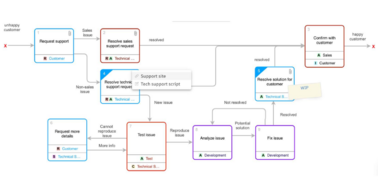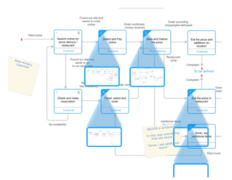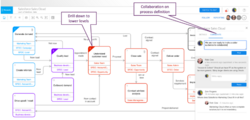Finance:Universal Process Notation
Universal Process Notation (UPN) is a graphical representation for specifying business processes. Developed by Nimbus Partners (later acquired by TIBCO Software) in 2008 as an open standard, UPN is not proprietary to any company and doesn't require any specialized software.[1] UPN's origins date back to the 1970s with IDEF0 but it has evolved to be perfect for the current day challenges of rapid business transformation, highly distributed teams and increasing regulatory compliance.[2] This solution to business process mapping creates a more accessible notation that stakeholders at all levels can understand.
Overview
Universal Process Mapping (UPN) is an open standard for business process modelling that provides a graphical notation for specifying business processes in a business process diagram (BPD), based on a flowcharting technique very similar to activity diagrams from Unified Modelling Language (UML). UPN provides a simplified approach to describing process flows using visual diagrams, focusing on documenting the actual 'manual' steps that are required in a process rather than on logical abstractions.[3] Business process maps enable business analysts to engage end-users and validate business requirements. Driving out waste, identifying improvements and forming the basis of user acceptance testing and training.[2]
By Simplifying the modelling system so that any user can quickly understand the process outlined without having to learn a new 'language' comprising numerous symbols and notation standards, UPN has been designed to provide an standard notation immediately understandable by all business stakeholders. Enabling various groups, including business analysts, technical developers and business managers; to effectively collaborate in mapping various processes, functions or business goals amongst other uses.
By creating a hierarchical process map, where every diagram is easier to follow [4]and activities are at the same level of abstraction, resulting in a diagram equally relevant to all business users. Providing usable process information to the executors of business process, while also encapsulating the technical needs of an IT audience. It is a universal and accessible notation for end-to-end process that is accessible and comprehensible to all areas of the business; regardless of background, seniority or discipline.
UPN Architecture
Creating a UPN based, end-to-end cross functional process which clearly communicates business objectives to all users ideally requires a top down approach. Producing not just a horizontal model from end-to-end but also vertical visibility for the purpose of process accountability and management.[5]
Elements of the standard
The UPN drawing notation can be summarized in this image of the activity box. All processes can be captured with just this one building block, these activity boxes answer the Who, What, When, Why and How of the business process.
Here are some critical aspects of UPN:
- Activity boxes have a resource rather than positioned on a swimlane.
- Lines with text exist between every activity box.
- Decisions are several lines coming out of an activity box with line text explaining flow.
- Drill downs give more detail.
- Attachments show documents/metadata/metrics in context.
The other fundamental principle of the UPN process mapping is hierarchy. Process diagrams are not meant to be stand-alone documents nor to be huge and complex; otherwise we risk losing context of how a particular process fits in with other operations or make them too big to understand. Each hierarchy level should describe events at the same level of abstraction.[6]
Process Diagrams
A process diagram is a collection of activity box and connecting flow lines that define a business process at the same level of detail. Enabling each individual user to understand business processes at varying levels of detail.[7]
Process Maps
A process of maps is a hierarchical collection of process diagrams
Diagramming Principles
In order to produce diagrams that can be viewed online and embedded into webpages and apps, process maps need to be small and easily understood.
- No more than 8-10 activity boxes on a screen.
- Activity boxes have 'drill downs' to capture sub processes.
- Supporting documentation, used systems and planned changes are captured against the activity box..
- An output from an activity box becomes an input trigger for the start of the next activity.
- Activity boxes feature 'resources' to signify who is involved in the execution of the activity.
Comparison with other process modelling notations
Flowcharts and swimlanes were the way most analysts and consultants used to capture requirements and business processes. UPN is a simpler and immediately understandable diagramming notation, proven in a range of businesses varying from major highly regulated industries to innovative start-ups and small non-profits[8]. Other notable process modelling notations include:
- Business Process Model and Notation (BMPN)
- Life-Cycle Modelling Language (LML)
- Subject-Oriented business process management (S-BPM)
- Extended Business Modelling Language (xBML)
- Unified Modelling Language (UML)
Alternative standards such as BMPN are often harder to read, due to the volume of different symbols and diagramming standards, despite being designed for similar purposes. Although the more complex notation offered may enable a more comprehensive modelling of the business process,[9] however these alternatives typically have narrower scope; whereas UPN is universal and applicable in more situations.
- Comparison between flowcharts and UPN
Jim Boots states in his book "Boots on the ground", which captures his experiences of running the Business Process Mapping program at Chevron;"*take any process drawn using flowcharting, swimlanes or BPMN notation and a UPN diagram will be smaller. Fact."[10]
From the images comparing a UPN Process Map to a traditional flowchart it is evident that the UPN Diagram is tighter, and more easily understood. With a clear left to right flow, more information and less ambiguity. Both diagrams describe the same flow.[11]
Further Reading
- Ian Gotts, Richard Parker (June 18, 2007). Common Approach, Uncommon Results: How Adoption Delivers the Results You Deserve. Ideas-Warehouse; 2nd Revised edition. ISBN-13 : 978-0954830915[12]
- The evolution of process diagramming
- Jim Boots (June 22, 2012). BPM Boots on the Ground: How to Implement Strategic Business Process Management: Lessons Learned from one of the World's Largest Organizations. ISBN-13 : 978-0929652160 [10]
References
- ↑ elementscloud (2016-06-01). "Universal Process Notation (UPN)" (in en-US). https://elements.cloud/2016/06/01/upn/.
- ↑ Jump up to: 2.0 2.1 "Introduction to Universal Process Notation (UPN) for Salesforce Processes Mapping" (in en-US). 2021-06-28. https://www.salesforceben.com/introduction-to-universal-process-notation-upn-for-salesforce-processes-mapping/.
- ↑ ricky (2017-03-27). "How Universal Process Notation (UPN) Drives Integration of Process Diagrams" (in en-US). https://www.clearsightconsulting.co.uk/how-upn-drives-integration-of-process-diagrams/.
- ↑ "Business Process Modeling Techniques • Checkify" (in en-GB). 2019-05-17. https://checkify.com/blog/business-process-modeling/.
- ↑ "TIBCO Nimbus UPN -universal-process-notation.pdf | Powered By Box". https://app.box.com/embed/preview/xqnvy6v0svd7g35nufkexd5nql1w8cb4?direction=ASC&theme=light.
- ↑ elementscloud. "Business process mapping" (in en-US). https://academy.elements.cloud/courses/process/.
- ↑ Bolduc, Benjamin; Hodgkins, Suzanne B.; Varner, Ruth K.; Crill, Patrick M.; McCalley, Carmody K.; Chanton, Jeffrey P.; Tyson, Gene W.; Riley, William J. et al. (13 August 2020). "Supplemental Information 3: An excerpt from Data Downloads page, where users can download original datasets.". PeerJ 8: e9467. doi:10.7717/peerj.9467/supp-3. http://dx.doi.org/10.7717/peerj.9467/supp-3. Retrieved 2021-05-21.
- ↑ Gotts @iangotts, Ian (2019-10-22). "The evolution of process diagramming" (in en). https://iangotts.medium.com/the-evolution-of-process-diagramming-266f8a447aab.
- ↑ ricky (2017-03-27). "How Universal Process Notation (UPN) Drives Integration of Process Diagrams" (in en-US). https://www.clearsightconsulting.co.uk/how-upn-drives-integration-of-process-diagrams/.
- ↑ Jump up to: 10.0 10.1 Boots, Jim (2012). Mr. Meghan-Kiffer Press. ISBN 978-0929652160.
- ↑ elementscloud (2016-06-01). "Universal Process Notation (UPN)" (in en-US). https://elements.cloud/2016/06/01/upn/.
- ↑ Gotts, Ian (2007). Mr. Ideas Warehouse. ISBN 978-0954830915.
External Links
Elements.Cloud Principles of Universal Process Notation
What is Universal Process Notation (UPN)?
Whitepaper: TIBCO Universal Process Notation: A simple solution for complex process diagrams
Elements.Cloud Universal Process Notation (UPN)
Salesforce trailhead UPN Course
 |








